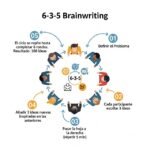
In today’s fast-paced world, innovation is the key to success for organizations seeking a competitive edge. To achieve this, companies are increasingly turning to artificial intelligence (AI), particularly natural language processing (NLP), as a powerful tool to tap into vast reservoirs of information from patent databases, online communities, social networks, and crowdsourcing platforms.
This strategic shift is revolutionizing the way we approach innovation, making NLP not just a technology but a vital intermediary that orchestrates invaluable knowledge and assists in open innovation practices.
Julian Just, a researcher at the University of Innsbruck, Team Innovation & Entrepreneurship, reviewed 167 academic articles to better understand how NLP approaches can enrich intermediation in early-stage innovation.
Innovation Intermediation
The concept of innovation intermediation describes the process of scanning, collecting, combining, and sharing innovation-related information facilitated by organizational agents.
Innovation intermediaries can perform essential activities in the early stages of the innovation process, such as forecasting, articulating needs and requirements, scanning and filtering information, or generating and negotiating knowledge.
On the other hand, the term “open innovation intermediary” describes formal or informal organizations that aim to facilitate open innovation activities and the discovery and exchange of knowledge between companies or individuals.
Artificial Intelligence Technologies
Technology makes it possible to automate the processing of large volumes of information and enhance human information processing capabilities to explore and select problems, opportunities, and solutions.
According to various scientific reports, artificial intelligence technologies such as machine learning, deep learning, NLP, computer vision, robotic process automation, among others, enable organizations to expand their information processing capabilities and rethink entire innovation processes.
In recent years, natural language processing (NLP) has gained interest in research on innovation and technology management.
NLP models can discover commonalities, filter essential from non-essential information, predict outcomes and typologies based on semantic text representations, and even generate new knowledge with minimal human effort.
Unlocking the Potential of NLP
Through this comprehensive review, the study identifies 18 distinctive innovation practices that NLP has adopted.
These practices redefine how we approach innovation by engaging in activities like trend prediction, visualizing technological landscapes, selecting novel ideas, merging analogous and domain-specific knowledge, and connecting problems with solutions.
Each of these practices relies on different NLP capabilities, reflecting the diverse toolbox that AI offers for innovation.
The study also reports that when NLP is applied to text data, patent databases are the most prevalent source, followed by ideas obtained from crowdsourcing platforms or databases and product reviews from e-commerce platforms or social networks.
The Power of Synergy
NLP capabilities do not work in isolation; they often complement each other in innovation processes. This synergy allows organizations to address complex problems from multiple angles.
“The integration of NLP approaches facilitates a new evolutionary level of capabilities to scan, structure, filter, and synthesize vast textual information,” the study emphasizes.
The study highlights that the choice of the most suitable NLP approach depends on the unique characteristics of the innovation practice in question.
A Paradigm Shift for Innovation
Both researchers and innovation professionals must adapt to this evolving landscape. The emergence of large language models (LLMs) exemplifies the transformative potential of AI in innovation. With this, the field presents numerous opportunities for future research and practical benefits.
Conclusion
Incorporating AI and NLP into early-stage innovation processes has the potential to reshape industries and drive progress. NLP is no longer just a technology; it is an innovation intermediary that orchestrates an invaluable symphony of information. The path forward is clear: as we harness the power of NLP, we must rethink our roles and responsibilities in AI-based innovation, ensuring we make the most of this rapidly evolving field.
However, as the study reports, “most of the reviewed studies demonstrate the capabilities of NLP approaches in illustrative cases without empirically validating or comparing the accuracy and applicability of the results.”
The future of innovation is here, driven by AI and NLP. To remain competitive and continue pushing boundaries, organizations must embrace this transformative technology.
As we navigate this exciting era of non-human innovation intermediaries, it is crucial to realize that NLP is not just a part of the journey; it is powering the very engine of innovation. The possibilities are limitless, and the potential is enormous.
Welcome to the future of innovation driven by AI and NLP.
Contact
Julian Just
University of Innsbruck, Team Innovation & Entrepreneurship
Universitätsstraße 15, 6020, Innsbruck, Austria
Email: julian.just@uibk.ac.at
Reference (Open Access)
Julian Just. 2023. Natural language processing for innovation search – Reviewing an emerging non-human innovation intermediary, Technovation, Volume 129, 2024, 102883, ISSN 0166-4972, https://doi.org/10.1016/j.technovation.2023.102883.
Editor and founder of “Innovar o Morir” (‘Innovate or Die’). Milthon holds a Master’s degree in Science and Innovation Management from the Polytechnic University of Valencia, with postgraduate diplomas in Business Innovation (UPV) and Market-Oriented Innovation Management (UPCH-Universitat Leipzig). He has practical experience in innovation management, having led the Fisheries Innovation Unit of the National Program for Innovation in Fisheries and Aquaculture (PNIPA) and worked as a consultant on open innovation diagnostics and technology watch. He firmly believes in the power of innovation and creativity as drivers of change and development.





